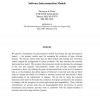Free Online Productivity Tools
i2Speak
i2Symbol
i2OCR
iTex2Img
iWeb2Print
iWeb2Shot
i2Type
iPdf2Split
iPdf2Merge
i2Bopomofo
i2Arabic
i2Style
i2Image
i2PDF
iLatex2Rtf
Sci2ools
ICSE
1987
IEEE-ACM
1987
IEEE-ACM
Software Interconnection Models
We present a formulation of interconnection models and present the unit and syntactic models -- the primary models used for managing the evolution of large software systems. We discuss various tools that use these models and evaluate how well these models support the management of system evolution. We then introduce the semantic interconnection model. The semantic interconnection model incorporates the advantages of the unit and syntactic interconnection models and provides extremely useful extensions to them. By refining the grain of interconnections to the level of semantics (that is, to the predicates that define aspects of behavior) we provide tools that are better suited to manage the details of evolution in software systems and that provide a better understanding of the implications of changes. We do this by using the semantic interconnection model to formalize the semantics of program construction, the semantics of changes, and the semantics of version equivalence and compatibi...
ICSE 1987 | Interconnection Model | Large Software Systems | Semantic Interconnection Model | Software Engineering |
Related Content
| Added | 28 Aug 2010 |
| Updated | 28 Aug 2010 |
| Type | Conference |
| Year | 1987 |
| Where | ICSE |
| Authors | Dewayne E. Perry |
Comments (0)

